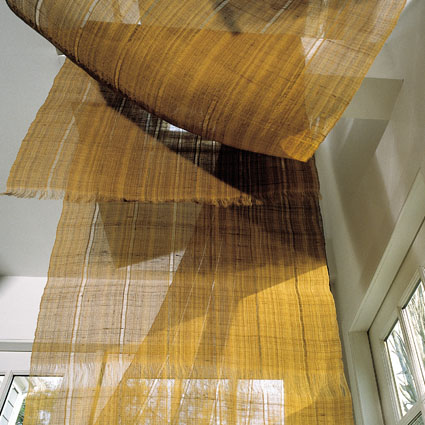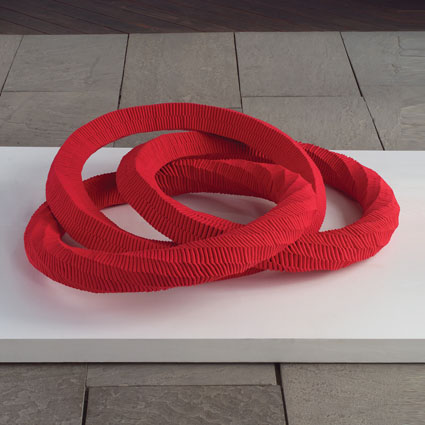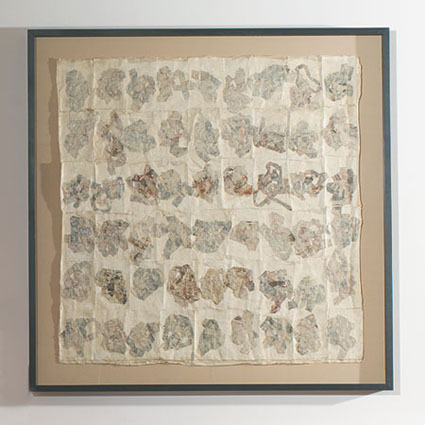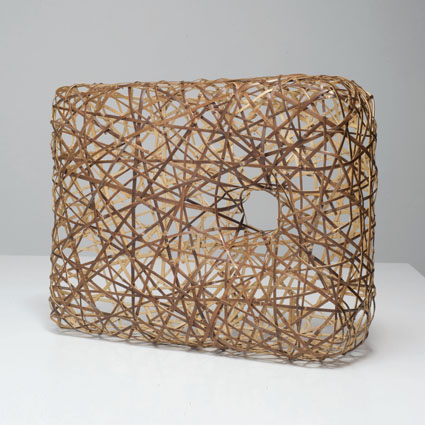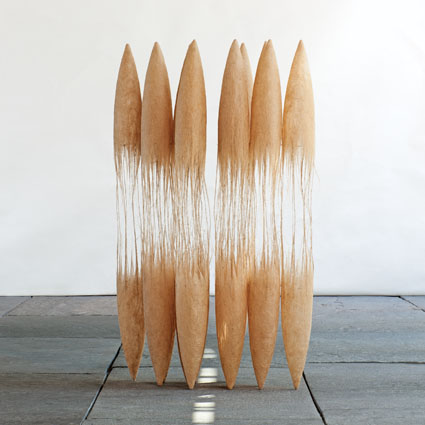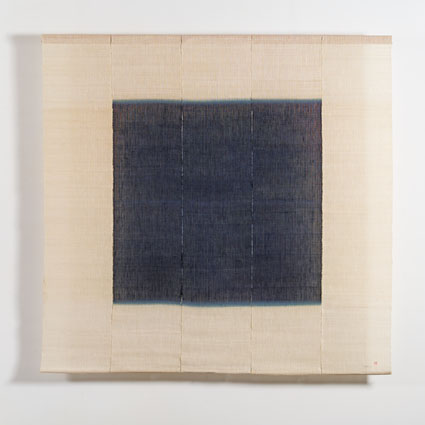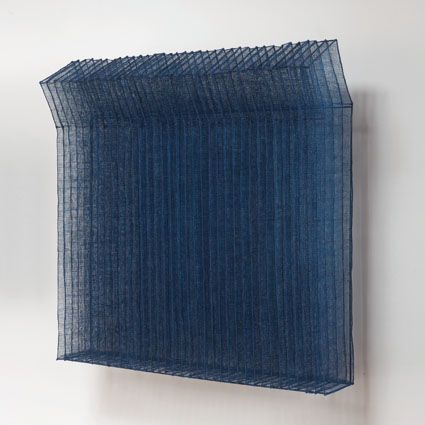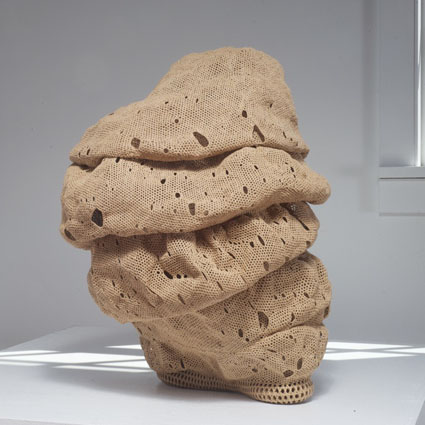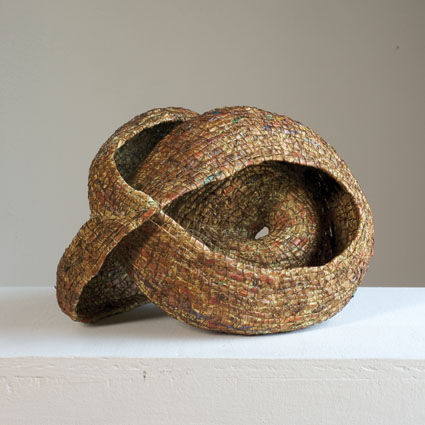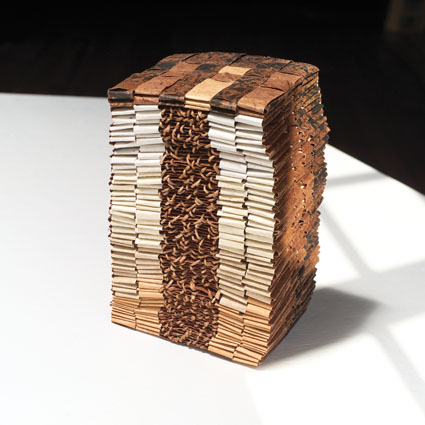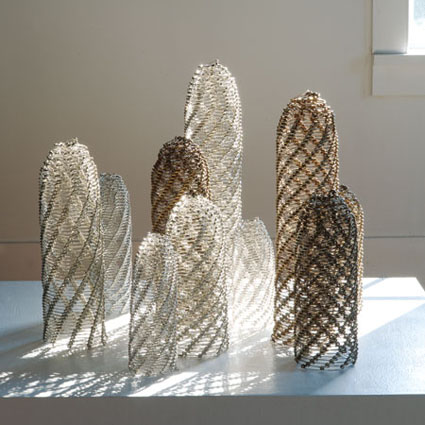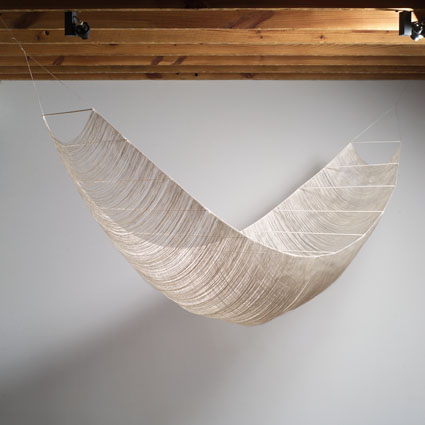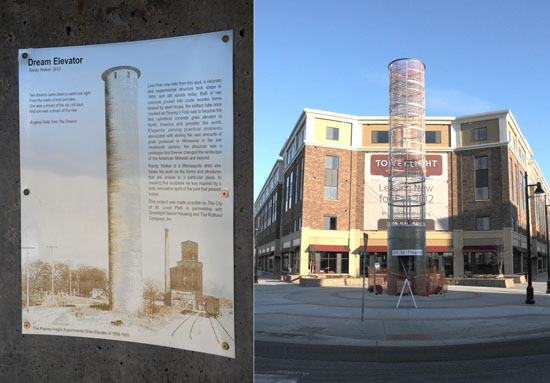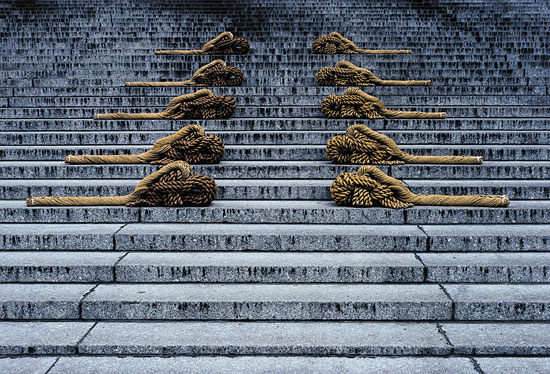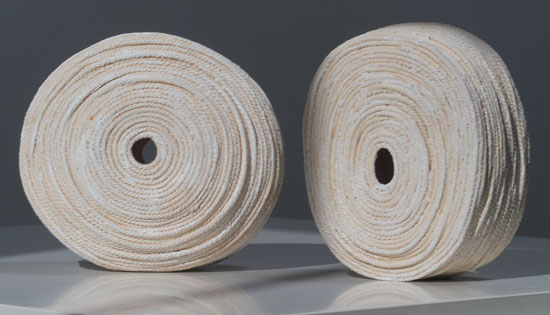Traditionally, art of Asia Week New York has been Asian Contemporary Art Week. This spring, Asian Contemporary Art Week extends beyond its usual week-long format to last an entire season, capturing the best of contemporary art from Asia in New York. A complete list of contemporary offerings, which includes Bomb Ponds, Vandy Rattana’s installation of photographs and video that explores the U.S. bombing of Cambodia during the Vietnam War, is found on the ACAW webiste at http://www.acaw.info/?page_id=2062. Here is a selection of wall and three-dimensional work by seven more contemporary Japanese artists.
In Honor of Asia Week: Three Artists from Korea
If you are planning to tour Asia Week New York 2013, there are a wide range of exhibitions, workshops and lectures to choose from. A complete list can be accessed here: http://www.asiaweekny.com/sites/asiaweekny/files/AWNY2013-Guide.pdf. Among the activities that interest us are Chunghie Lee’s exhibition and workshop, Bojagi: Cloth, Color & Beyond by Chunghie Lee, through May 31st, and Wedding Bojagi Workshop, Friday the15th and Saturday the 16th, both at the Korea Society, 950 Third Ave., 8th Floor, New York, New York, 10022; and Seven Sages of Ceramics: Modern Japanese Masters at Joan B. Mirviss Ltd. through April 26th, 39 East 78th Street, New York, NY 10075;. For those touring chairside, enjoy these works by three accomplished artists from Korea.
In Honor of Asia Week: Nine Japanese Artists
Asia Week New York 2013, March 15th to March 23rd is a nine-day celebration of Asian art throughout metropolitan New York, with exhibitions, auctions and special events presented by 43 leading international Asian art specialists, five major auction houses, and 17 museums and cultural institutions; http://www.asiaweekny.com. Not going to be in New York this month? Not to worry, over the next few days, we’ll bring some striking examples of Asian art, more than two dozen works, in fact, to a desktop, laptop, tablet or phone near you. Here’s the first of four installments, featuring nine artists from Japan.
Kiyomi Iwata (Japan.United States)
Against the Grain: Randy Walker’s Dream Elevator and Other News
December 2012 saw completion of Dream Elevator by Randy Walker for the City of St. Louis Park, Minnesota. The structure is a 45-foot tall stainless-steel-and-concrete tower woven with custom-braided polyester rope. The sculpture is inspired by the nearby Peavey-Haglin Grain Elevator of 1899, the first cylindrical concrete grain elevator in the world.
The dedication date of Dream Elevator is as yet undetermined. This year and next, Walker will be at work on at least four public commissions. First, a permanent outdoor work, Sky Portal, for the Anderson Abruzzo International Balloon Museum in Albuquerque, New Mexico, which will be visible from the sky as well as the ground. Second, Entanglement, in Scottsdale, Arizona, where Walker will use an existing bell tower as a framework for a fibrous wrapping.
Third, a temporary, site-specific installation will be built at the two main cargo shipping terminals in San Diego, California that will be part of WRAP: an artistic investigation of the San Diego Tidelands. Finally, Walker will work with his South Minneapolis community to create a large-scale, collaborative installation for which Walker received a Minnesota State Arts Board Artist Initiative Grant.
This Month’s Don’t Miss Exhibitions
through January 20, 2013
High Fiber: Recent Large Scale Acquisitions in Fiber
Racine Art Museum
Racine, Wisconsin
High Fiber transforms RAM’s largest gallery space with larger-than-life size sculpture by significant contemporary artists who have established reputations working with fibers such as fabric, metal wire, and cedar. Created with techniques like weaving and knotting––and touching on a variety of subjects including metaphysics, the human condition, and the natural world––the works featured in this exhibition delight the eye and engage the mind. The artists whose work is included are: Nancy Hemenway Barton, Carol Eckert, Françoise Grossen, Jan Hopkins, Michael James, Ruth Lee Kao, Nancy Koenigsberg, Gyöngy Laky, Rebecca Medel, Linda Kelly Osborne, Barbara Lee Smith, Jean Stamsta, Merle Temkin, Dawn Walden and Claire Zeisler. For more information, call: 262.638.8300 or visit: http://www.ramart.org/sites/default/files/userfiles/exhibitions/2012/HighFiber/High Fiber Notes.pdf.
opened January 12th
Green from the Get Go: International Contemporary Basketmakers
Edsel & Eleanor Ford House, Visitor Center GalleryGrosse Pointe, Michigan
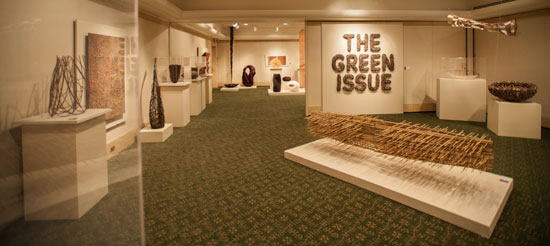
Green from the Get Go: Contemporary International Basketmakers installation at the Edsel & Eleanor Ford House, photo by tom grotta
Green from the Get Go: International Contemporary Basketmakers, curated by browngrotta arts and Jane Milosch, former curator of the Renwick Gallery, Smithsonian American Art Museum, opens at the Visitor Center Gallery of the Edsel & Eleanor Ford House in Grosse Pointe, Michigan and runs through March 9th. The Edsel & Eleanor Ford House is at 110 Lake Shore Road, Grosse Pointe, Michigan, 48236. Hours are 11 a.m to 5 p.m. Tuesday through Sunday. For more information call: 313.884.4222 or visit: http://www.fordhouse.org/calendar.html?month=&year=&cat=&cid=8691.
opened January 12th
Aleksandra (Sasha) Stoyanov: Warp and Weft Painting
Tefen Open Museum
P.O.B. 1
Migdal Tefen, Israel 24959
Art Gallery: 04-9109613; Visitors Department: 04-9872022; 04-9109609
The Tefen Open Museum exhibition features a large grouping of Stoyanov’s painterly weavings, whose subjects feel like dream fragments or half-forgotten memories. There is a catalog for the exhibition, which is open through August 2013, http://store.browngrotta.com/aleksandra-sasha-stoyanov-warp-and-weft-painting/. It features an essay by Davira Taragin and will be available through browngrotta arts. Stoyanov’s work, From the First Person – Number II, has recently been added to the permanent collection of the Metropolitan Museum in New York.
opening January 17th
Lenore Tawney: Wholly Unlooked For
University of the Arts
Rosenwald-Wolf Gallery
Philadelphia, Pennsylvania
The University of the Arts presents an exhibition by late artist Lenore Tawney (1907–2007), a leading figure in the contemporary fiber arts movement. Presented in conjunction with the Lenore G. Tawney Foundation, the exhibition, which runs through March 2nd, will feature her paper-focused pieces. For more information, visit: http://www.uarts.edu/.The Maryland Institute College of Art, Tawney’s alma mater, is hosting a complementary exhibition, http://www.mica.edu/News/Multi-Venue_Exhibition_Honors_Legendary_Fiber_Artist_Lenore_Tawney_H92_(1907–2007)_This_Winter_.html under the same, title featuring her line-based objects.
Opening Reception: January 24, 5 – 7:30 p.m.
University of the Arts
Rosenwald-Wolf Gallery
Philadelphia, Pennsylvania
Panel Discussion: January 24, 2 – 4 p.m.
The Legacy of Lenore Tawney
University of the Arts
CBS Auditorium, Hamilton Hall
Panelists: Jack Lenor Larsen: dean of Modern Textile Design, founder of LongHouse, Honory Doctorate, University of the Arts; Kathleen Nugent Mangan: director of the Lenore G. Tawney Foundation; Dr. Suzanne Hudson: assistant professor, University of Southern California; Warren Seelig: artist, distinguished visiting professor, University of the Arts; Moderator: Sid Sachs: director of exhibitions, University of the Arts.
opening January 22nd
MFA Book Arts and Crafts/Fibers Exhibition
Gallery 224 & President’s Office
University of the Arts
Philadelphia, Pennsylvania
This exhibit features work by University of the Arts students in the MFA in Book Arts/Printmaking and Crafts/Fibers programs, who have each created a piece in response to Lenore Tawney’s work. The students researched an extraordinary collection of objects from the Lenore Tawney Foundation, including old books and parts of old books, wood containers, small bottles and thread, which they incorporated and used as inspiration for their exhibition pieces. The exhibition runs through February 8th. For more information, visit: http://www.uarts.edu/.
Books Make Great Gifts 2013 – Part II
More book recommendations from artists and us.
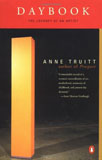

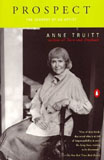 “There are a series of books, journals, Daybook, Turn, and Prospect, by Anne Truitt, the minimalist sculptor,” Mary Merkel-Hess writes, “that were important to me when I was a young artist. In a marvelously lucid way, Anne Truitt wrote about her life in the studio, her marriage, children, and making a living at art. Particularly interesting to me was her discussion, in her first book, about turning away from a life of doing ‘good’ in the world (she studied clinical psychology and worked as a nurse) to become an artist.”
“There are a series of books, journals, Daybook, Turn, and Prospect, by Anne Truitt, the minimalist sculptor,” Mary Merkel-Hess writes, “that were important to me when I was a young artist. In a marvelously lucid way, Anne Truitt wrote about her life in the studio, her marriage, children, and making a living at art. Particularly interesting to me was her discussion, in her first book, about turning away from a life of doing ‘good’ in the world (she studied clinical psychology and worked as a nurse) to become an artist.”
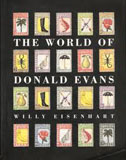 Nancy Moore Bess, recommends The World of Donald Evans by Willy Eisenhart. “I had purchased some bookmarks with his watercolor ‘stamps’ and was excited to see a book about him. His work is visually so rich and really reflects his life…which tragically ended in a fire at his studio in 1977. If you ever find a copy, curl up with it yourself.”
Nancy Moore Bess, recommends The World of Donald Evans by Willy Eisenhart. “I had purchased some bookmarks with his watercolor ‘stamps’ and was excited to see a book about him. His work is visually so rich and really reflects his life…which tragically ended in a fire at his studio in 1977. If you ever find a copy, curl up with it yourself.”
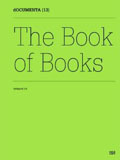 For Heidrun Schimmel, Documenta 13, was one of the best ‘documenta’ exhibitions and the publications — there are three — give a great deal of information about the art scene, the questions and problems of our world. Documenta 13’s Artistic Director Carolyn Christov-Bakargiev described the 2012 festival as “choreographing many different kinds of materials, methodologies and forms of knowledge.” One of the three publications, Documenta 13: The Book of Books reproduces the entire 100 Notes – 100 Thoughts series of publications (either as facsimiles or with entirely new layouts), and is supplemented by essays from Carolyn Christov-Bakargiev, Chus Martínez, Franco Berardi and others, plus statements by some of the festival’s agents and advisors. Heidrun also recommends
For Heidrun Schimmel, Documenta 13, was one of the best ‘documenta’ exhibitions and the publications — there are three — give a great deal of information about the art scene, the questions and problems of our world. Documenta 13’s Artistic Director Carolyn Christov-Bakargiev described the 2012 festival as “choreographing many different kinds of materials, methodologies and forms of knowledge.” One of the three publications, Documenta 13: The Book of Books reproduces the entire 100 Notes – 100 Thoughts series of publications (either as facsimiles or with entirely new layouts), and is supplemented by essays from Carolyn Christov-Bakargiev, Chus Martínez, Franco Berardi and others, plus statements by some of the festival’s agents and advisors. Heidrun also recommends 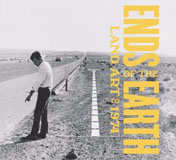 Ends of the Earth, Art of the Land to 1974, by Philipp Kaiser, Miwon Kwon, Tom Holert and Julian Meyers. The companion exhibition is at Haus der Kunst, Prinzregentenstraße 1 in Munich,
Ends of the Earth, Art of the Land to 1974, by Philipp Kaiser, Miwon Kwon, Tom Holert and Julian Meyers. The companion exhibition is at Haus der Kunst, Prinzregentenstraße 1 in Munich,
Germany through January 20, 2013. “I think this exhibition is very important for anyone who is working with ‘material as matter,’ perhaps especially for artists of my generation who remember this revolution in art history.”
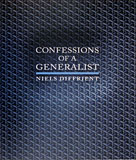 I am thoroughly enjoying Confessions of a Generalist, by Niels Diffrient, as I have a few moments to read amidst holiday prep and end-of-year items. Niels is a friend, the spouse of tapestry artist Helena Hernmarck and designer of the Freedom, Liberty and World ergonomic chairs. His is a remarkable journey — from a Mississippi farm to Cranbrook to Italy, to work with Eero Saarinen, Buckminister Fuller, Henry Dreyfuss and for Edwin Land, on every every type of equipment, as well as computers, exhibits, trucks, airplane interiors and corporate identity programs. The book is lavishly illustrated and captioned and Niels succeeds in his aim of creating a “communication product,” that closely relates words and pictures, both physically and intellectually, and approximates “the way we experience reality with both our intellect and senses.”
I am thoroughly enjoying Confessions of a Generalist, by Niels Diffrient, as I have a few moments to read amidst holiday prep and end-of-year items. Niels is a friend, the spouse of tapestry artist Helena Hernmarck and designer of the Freedom, Liberty and World ergonomic chairs. His is a remarkable journey — from a Mississippi farm to Cranbrook to Italy, to work with Eero Saarinen, Buckminister Fuller, Henry Dreyfuss and for Edwin Land, on every every type of equipment, as well as computers, exhibits, trucks, airplane interiors and corporate identity programs. The book is lavishly illustrated and captioned and Niels succeeds in his aim of creating a “communication product,” that closely relates words and pictures, both physically and intellectually, and approximates “the way we experience reality with both our intellect and senses.”
Looking Forward/Looking Back: Ruth Kaufmann
“Americans were late arrivals in the field of tapestry weaving, which may account to some degree for the fact that the American tapestry weaver is less bound by tradition than his European colleague. His historical background, however, is probably the major factor. He projects into his work some of the dynamic exploratory spirit and inventiveness that are part of his pioneer past. He feels free to investigate, to challenge old established methods, and to extend the many possibilities of his medium. Furthermore, instead of undergoing the discipline of apprenticeship, he is in most instances trained in the art and craft departments of universities. Exposure to the entire field of art, its interaction and overlapping, results in a broader, more sophisticated attitude….
Although our American artist-weavers have assimilated ideas from other countries, other times, and other art media, they have translated and utilized these entirely in terms of their own identity. A compelling new form of weaving has recently appeared as a result of their unhampered experimentation — free hanging two- and three-dimensional woven objects. These stunning sculptural creations have refused to stay passively on the wall. Instead, they have moved into space. Enthusiastically received by weavers and art lovers here and abroad, they have added a promising new dimension to the craft.”
Ruth Kaufmann
The New American Tapestry
(Reinhold Book Corporation, NY.Amsterdam.London, 1968, pp. 10-11)
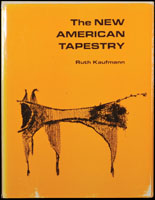
Born and educated in Germany, Ms. Kaufmann studied fashion and design, textile design under Lili Blumenau, rug-weaving with with designer Margit Pardo, and tapestry weaving with renowned artist Martta Taipale of Finland. In 1968, Ms. Kaufmann was one of the American tapestry weavers who exhibited with American Craftsman, Inc. in New York. In 1969, she opened the Ruth Kaufmann Gallery in New York.
Books Make Great Gifts 2013 — Part I
It’s that time of year again. Over the next few weeks, we’ll offer a wrap up of books that the artists, clients and staff of browngrotta arts have been reading and thinking about this year.
Kiyomi Iwata recommends
 Blood, Bones and Butter by Gabrielle Hamilton. Hamilton is an owner of a restaurant called Prune in New York’s East Village but she is a chef, writer and an artist. This book also comes highly recommended by collectors/family members Sandra and Lou Grotta. Kiyomi’s second choice is
Blood, Bones and Butter by Gabrielle Hamilton. Hamilton is an owner of a restaurant called Prune in New York’s East Village but she is a chef, writer and an artist. This book also comes highly recommended by collectors/family members Sandra and Lou Grotta. Kiyomi’s second choice is
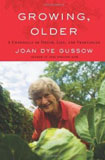 Growing, Older, A Chronicle of Death, Life, and Vegetables by Joan Dye Gussow, Chelsea Green Publishing. “Gussow is a pioneer of the ‘Eat Local’ movement,” Kiyomi writes, ” and a very honest and funny writer.”
Growing, Older, A Chronicle of Death, Life, and Vegetables by Joan Dye Gussow, Chelsea Green Publishing. “Gussow is a pioneer of the ‘Eat Local’ movement,” Kiyomi writes, ” and a very honest and funny writer.”
Dail Behennah admitted it was hard to whittle down her recommendations for books to read, but here goes: “The best book I have read this year is 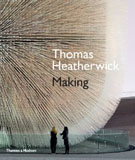 Making by Thomas Heatherwick and Maisie Rowe, published to accompany the exhibition at the V&A.” The 600 pages of drawings and photographs show the work of the designer Thomas Heatherwick and his Studio, with beautifully written explanations of each project. Arranged chronologically, each project is headed with a question “Can a giant sculpture fit through a letterbox?” “Can straight pieces of wood make a curved building?” Heatherwick’s enthusiasm for these problems is infectious, and he always comes up with an unpredictable solution which is elegant and deceptively simple. “I am sure,” she adds, ” that this is a book that I will return to over and over again.” The book that Dail is eagerly awaiting is
Making by Thomas Heatherwick and Maisie Rowe, published to accompany the exhibition at the V&A.” The 600 pages of drawings and photographs show the work of the designer Thomas Heatherwick and his Studio, with beautifully written explanations of each project. Arranged chronologically, each project is headed with a question “Can a giant sculpture fit through a letterbox?” “Can straight pieces of wood make a curved building?” Heatherwick’s enthusiasm for these problems is infectious, and he always comes up with an unpredictable solution which is elegant and deceptively simple. “I am sure,” she adds, ” that this is a book that I will return to over and over again.” The book that Dail is eagerly awaiting is 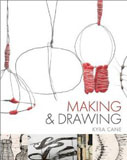 Making and Drawing by Kyra Cane to be published this month by A & C Black. “It promises to provide inspiration and an insight into the way other makers think.” she writes. “Some of my favorite makers are included and I hope that it might change the way I draw. Some of my plans on graph paper are included in the chapter, “Drawing as Planning & Design.”
Making and Drawing by Kyra Cane to be published this month by A & C Black. “It promises to provide inspiration and an insight into the way other makers think.” she writes. “Some of my favorite makers are included and I hope that it might change the way I draw. Some of my plans on graph paper are included in the chapter, “Drawing as Planning & Design.”
A book that Gyöngy Laky predicts could be just the right gift for an art lover is 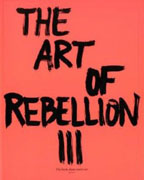 The Art of Rebellion III The book about street art by Christian Hundertmark. “I am intrigued by much of the free wheeling creativity and great skill I see in graffiti but also troubled by it – particularly when it is destructive, unwanted and messy, ” Laky writes. “The front of our house got tagged one night with ugly, awkward, large, purple marks. We were not happy. In this book, however, the works go beyond just graffiti to surprising street art, clever and comic installations, thoughtful environmental art or engaging guerrilla works. There are numerous, creative, inventive, original, playful, funny, crazy and fantastic conceptual works that will delight and inspire the reader. These artistic expressions do present a perplexing problem; if they are wonderful events and brilliantly creative, but made illegally and clandestinely on private property or public areas where they should not be made, can we still love and appreciate them?”
The Art of Rebellion III The book about street art by Christian Hundertmark. “I am intrigued by much of the free wheeling creativity and great skill I see in graffiti but also troubled by it – particularly when it is destructive, unwanted and messy, ” Laky writes. “The front of our house got tagged one night with ugly, awkward, large, purple marks. We were not happy. In this book, however, the works go beyond just graffiti to surprising street art, clever and comic installations, thoughtful environmental art or engaging guerrilla works. There are numerous, creative, inventive, original, playful, funny, crazy and fantastic conceptual works that will delight and inspire the reader. These artistic expressions do present a perplexing problem; if they are wonderful events and brilliantly creative, but made illegally and clandestinely on private property or public areas where they should not be made, can we still love and appreciate them?”
Ane Henricksen wrote us about Dr. Jessica Hemmings new book,  Warp & Weft: Woven Textiles in Fashion, Art and Interiors. The book has six chapters: “Threads,” “All Kinds of Light,” “Dynamic Responses,” “Sound,” “Community” and “Emotion.” Described by its publisher as, “[a]n excellent resource for everyone with an interest in modern, woven textiles,” this book features work by Nuno, Ane Henricksen, Grethe Sørensen, Lia Cook and many others.
Warp & Weft: Woven Textiles in Fashion, Art and Interiors. The book has six chapters: “Threads,” “All Kinds of Light,” “Dynamic Responses,” “Sound,” “Community” and “Emotion.” Described by its publisher as, “[a]n excellent resource for everyone with an interest in modern, woven textiles,” this book features work by Nuno, Ane Henricksen, Grethe Sørensen, Lia Cook and many others.
Looking Forward/Looking Back: Françoise Grossen
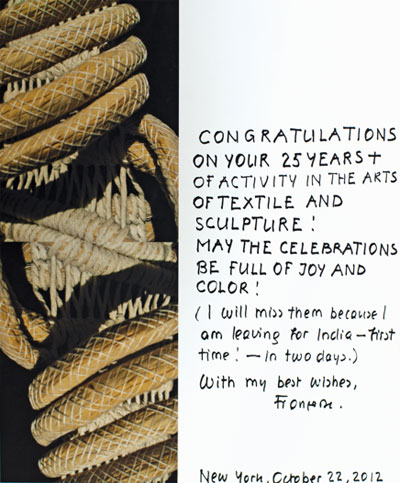 Earlier this year, Françoise Grossen sent bga these congratulations on our 25th anniversary. Grossen’s remarkable contributions to the field predate ours. In 1972, her work was featured in, “Rope Art: A new form fit to be tied,” in Life Magazine in an article on the exhibition Deliberate Entanglements. “Françoise Grossen, a Swiss better at knotting than entomology, concocted a 20-foot Inch Worm” the magazine wrote. “Some viewers at New York’s Museum of Contemporary Crafts thought it moved.” (Life Magazine, December 1, 1972, pp.86-90). This year, Grosssen’s work, Ahnen Galerie, 10 braided bundles of dyed manila rope with appendages, 13 x 116 x 92 inches, was acquired by the Racine Art Museum. Ahnen Galerie is now on display in High Fiber: Recent Large-Scale Acquisitions in Fiber, http://www.ramart.org/content/high-fiber-recent-large-scale-acquisitions-fiber, at the Racine Museum of Art through January 20, 2013.
Earlier this year, Françoise Grossen sent bga these congratulations on our 25th anniversary. Grossen’s remarkable contributions to the field predate ours. In 1972, her work was featured in, “Rope Art: A new form fit to be tied,” in Life Magazine in an article on the exhibition Deliberate Entanglements. “Françoise Grossen, a Swiss better at knotting than entomology, concocted a 20-foot Inch Worm” the magazine wrote. “Some viewers at New York’s Museum of Contemporary Crafts thought it moved.” (Life Magazine, December 1, 1972, pp.86-90). This year, Grosssen’s work, Ahnen Galerie, 10 braided bundles of dyed manila rope with appendages, 13 x 116 x 92 inches, was acquired by the Racine Art Museum. Ahnen Galerie is now on display in High Fiber: Recent Large-Scale Acquisitions in Fiber, http://www.ramart.org/content/high-fiber-recent-large-scale-acquisitions-fiber, at the Racine Museum of Art through January 20, 2013.
November 26th: Our Online Exhibition Opens With an Offer for CyberMonday
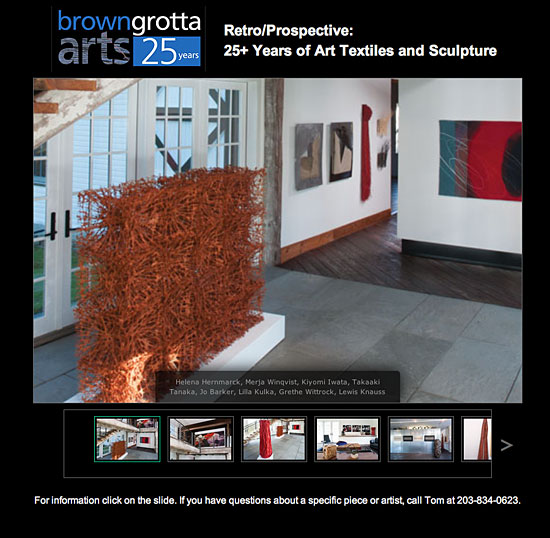 On Monday, November 26th, browngrotta arts will present an online version of our 25th anniversary exhibition,Retro/Prospective: 25+ Years of Art Textiles and Sculpture at browngrotta.com. The comprehensive exhibition highlights browngrotta arts’ 25 years promoting international contemporary art. Viewers can click on any image in the online exhibition to reach a page with more information about the artists and their work.
On Monday, November 26th, browngrotta arts will present an online version of our 25th anniversary exhibition,Retro/Prospective: 25+ Years of Art Textiles and Sculpture at browngrotta.com. The comprehensive exhibition highlights browngrotta arts’ 25 years promoting international contemporary art. Viewers can click on any image in the online exhibition to reach a page with more information about the artists and their work.
“Some works in Retro/Prospective: 25+ Years of Art Textiles and Sculpture reflect the early days of contemporary textile art and sculpture movement,” says Tom Grotta, founder and co-curator at browngrotta arts. “There are also current works by both established and emerging artists, which provide an indication of where the movement is now and where it may be headed.”
Since Monday the 26th is CyberMonday this year, sales of art, books, catalogs, videos or dvds placed online or by telephone that day will be discounted 10% (excluding tax and shipping). In addition, bga will make a donation to the International Child Art Foundation for each sale made from November 24th through December 31, 2012. Visit browngrotta.com. For more information call Tom at 203.834.0623 or email us at art@browngrotta.com.
Search
Subscribe2
Recent Posts
- December 19, 2025
- December 10, 2025
- December 3, 2025
Pages
blogroll
Archives
- December 2025
- November 2025
- October 2025
- September 2025
- August 2025
- July 2025
- June 2025
- May 2025
- April 2025
- March 2025
- February 2025
- January 2025
- December 2024
- November 2024
- October 2024
- September 2024
- August 2024
- July 2024
- June 2024
- May 2024
- April 2024
- March 2024
- February 2024
- January 2024
- December 2023
- November 2023
- October 2023
- September 2023
- August 2023
- July 2023
- June 2023
- May 2023
- April 2023
- March 2023
- February 2023
- January 2023
- December 2022
- November 2022
- October 2022
- September 2022
- August 2022
- July 2022
- June 2022
- May 2022
- April 2022
- March 2022
- February 2022
- January 2022
- December 2021
- November 2021
- October 2021
- September 2021
- August 2021
- July 2021
- June 2021
- May 2021
- April 2021
- March 2021
- February 2021
- January 2021
- December 2020
- November 2020
- October 2020
- September 2020
- August 2020
- July 2020
- June 2020
- May 2020
- April 2020
- March 2020
- February 2020
- January 2020
- December 2019
- November 2019
- October 2019
- September 2019
- August 2019
- July 2019
- June 2019
- May 2019
- April 2019
- March 2019
- February 2019
- January 2019
- December 2018
- November 2018
- October 2018
- September 2018
- August 2018
- July 2018
- June 2018
- May 2018
- April 2018
- March 2018
- February 2018
- January 2018
- December 2017
- November 2017
- October 2017
- September 2017
- August 2017
- July 2017
- June 2017
- May 2017
- April 2017
- March 2017
- February 2017
- January 2017
- December 2016
- November 2016
- October 2016
- September 2016
- August 2016
- June 2016
- April 2016
- March 2016
- February 2016
- December 2015
- October 2015
- September 2015
- August 2015
- June 2015
- May 2015
- April 2015
- March 2015
- February 2015
- January 2015
- December 2014
- November 2014
- October 2014
- September 2014
- August 2014
- July 2014
- June 2014
- May 2014
- April 2014
- March 2014
- February 2014
- January 2014
- December 2013
- October 2013
- September 2013
- July 2013
- June 2013
- May 2013
- April 2013
- March 2013
- January 2013
- December 2012
- November 2012
- October 2012
- September 2012
- August 2012
- July 2012
- June 2012
- May 2012
- April 2012
- March 2012
- February 2012
- January 2012
- December 2011
- November 2011
- October 2011
- September 2011
- August 2011
- July 2011
- June 2011
- May 2011
- April 2011
- March 2011
- February 2011
- January 2011
- December 2010
- November 2010
- October 2010
- September 2010
- August 2010
- July 2010
- June 2010
- May 2010
- April 2010
- March 2010
- February 2010
- January 2010
- December 2009
- November 2009
- October 2009
- September 2009
- August 2009
Categories
- Acquisitions
- Aldrich Museum of Contemporary Art
- Allies for Art
- An Unexpected Approach
- Anniversary
- Architecture
- Art
- art + identity
- Art Assembled
- Art Materials
- art money
- Art Preview
- Art Textiles
- artist
- Artsy
- Awards
- bamboo
- Basketmakers
- Basketry
- Behind the Scenes
- Blue/Green
- Book Recommendations
- Books
- Catalogs
- Ceramics
- Charity
- Classes
- Collage
- Collectors
- Commentary
- Commission
- Commissions
- Danish Tapestry
- DIY
- Eco-Art
- Exhibitions
- Fashion
- Fiber Future
- Fiber Sculpture
- Film
- Galleries
- Gifts
- Guest Post
- History
- In the News
- Installations
- Japandi
- Japanese Art
- Japanese Ceramics
- Lectures
- Mixed Media
- Museums
- New This Week
- New York
- Obituary
- Obiturary
- Outdoors
- Paper
- Philadephia Museum of Art
- Photography
- Politics
- Pop-Up Exhibition
- Press
- Process Notes
- Sculpture
- SOFA
- Sweepstakes
- Tapestry
- tate modern
- Technology
- Text Art
- Travel
- Uncategorized
- Volume 50: Chronicling Fiber Art for Three Decades
- White
- White Art
- Who Said What
- Wood
- Workshops
Tags
Adela Akers art assembled Basketry browngrotta arts Carolina Yrarrázaval Dorothy Gill Barnes Ed Rossbach Gyöngy Laky Heidrun Schimmel Helena Hernmarck Hisako Sekijima James Bassler Jane Balsgaard Jennifer Falck Linssen Jin-Sook So Jiro Yonezawa John McQueen Judy Mulford Karyl Sisson Kay Sekimachi Kiyomi Iwata Kyoko KumaI Lawrence LaBianca Lenore Tawney Lewis Knauss Lia Cook Magdalena Abakanowicz Marian Bijlenga Mariette Rousseau-Vermette Mary Giles Mary Merkel-Hess Nancy Koenigsberg Nancy Moore Bess Naoko Serino Naomi Kobayashi Norma Minkowitz Rachel Max Randy Walker Sheila Hicks Sheila hicks Stéphanie Jacques Sue Lawty Tapestry Wendy Wahl Yasuhisa KohyamaAbout browngrotta.com
blogroll
reboot
site-ings
who's showing where
Subscribe
Pages
Archives
Calendar

